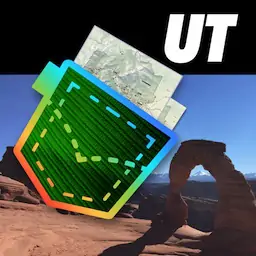by Alex Gugel , all rights reserved
PronghornBryce Canyon |
featured in
| National Parks Pocket Maps |  | |
| Utah Pocket Maps |  |
Bryce Canyon
National Park Service
U.S. Department of the Interior
Bryce Canyon National Park
Pronghorn
(Antilocapra americana)
Their scientific name, Antilocapra americana, means “American Antelope
Goat,” but they are not closely related to the antelopes of Africa and Asia. They
are the fastest land animals in the western hemisphere, and they are a link to
the past as one of the few remaining survivors of the last Ice Age. Pronghorns
evolved when the hemisphere was home to the American Cheetah as well as
other large predators and, in order to survive, they had to be fast.
Vital Statistics
Named for the forward facing prong on
the buck’s horns, they are often referred
to as antelope or Pronghorn Antelope,
however, the correct common name is
simply Pronghorn. Their horns are unique in
the animal kingdom and shared by no living
other species. Antlers are bone and shed
each year, while bovine horns are permanent
and are bone covered with a keratin sheath
(hair and nails are keratin). The Pronghorn
is similar to the bovine family in that they
have bone covered with a keratin sheath, but
with one major exception: the keratin sheath
is shed each year after the breeding season,
the regrows each Spring.
Not large animals, Pronghorn have eyes as
large as a horse, are able to detect movement
up to 4 miles/6.5 km away, and have a field
of view of more than 300 degrees.
A Lone Survivor
Always on the alert, a Pronghorn Doe.
The males average 3 ft. (0.9 m) tall,
60 in.(1.5 m) in length, and weigh
120 pounds (55 kg). The females are
approximately 10% smaller.
The modern Pronghorn’s earliest ancestors
appear in the fossil record from the Miocene
Epoch, about 20 million years ago. The
family continued to evolve and expand
over the millennia and there are fossils
representing at least 12 different species.
Bones of the modern Pronghorn, dating to
about 10,000 years ago, have been found in
California’s La Brea Tar Pits.
North America was a very different
place and by late in the Pliocene Epoch,
in addition to the pronghorns, North
America was also home to several species
we associate with modern Africa: lions,
cheetahs, and hyenas. In addition, there
were saber-toothed cats and short-faced
bears that, combined with those mentioned
earlier, made for some very formidable
predators. For an even-toed ungulate living
in such a dangerous time, speed was the only
defense in the struggle for survival.
When humans first arrived in North
America 13,000 years ago there were five
pronghorn species. By the end of the
Pleistocene Epoch, about 11,000 years
ago, the planet had entered the last Ice Age
and North America seemed to be hardest
hit. Mass extinctions during that period
included mammoths, mastodons, the big
cats, and all but this one surviving member
of the pronghorn family.
Lifestyles
Pronghorn inhabit grasslands, deserts,
and sagebrush flats of western North
America from Canada’s prairies to
northern Mexico at elevations from 4,000
to 8,000 feet (1220 to 2400 meters). Since
they rely on vision and speed for predator
avoidance, wide open spaces with low
vegetation are critical for survival. Herds,
depending on location, will migrate from
just a few miles/kilometers to over 150
miles (240 km) between summer and
winter forage. Pronghorn are a frequent
sight in the meadows at Bryce Canyon
from spring through fall, but retreat to
lower elevations, where there is less snow,
in the winter.
Pronghorn are ruminants with fourchambered stomachs much like those of
members of the deer and bovine families.
Their diet consists chiefly of forbs, shrubs,
and, especially in winter, sagebrush. They
rarely eat grasses but will, in arid or desert
environments, eat cactus. Herds tend to
be larger during the winter months, then
break up into smaller groups in spring
and summer. Pregnant females leave the
Conservation
Twin fawns nursing while the doe maintains a
constant vigil.
herds in May or June to find a secluded
location to give birth.
Adults have no living natural predators
except when old, sick, or injured. While
vulnerable, the family heritage of speed
is present even in the fawns. At the age
of four days they can outrun the average
human and, by three to four weeks, can
already outrun a coyote or bobcat. Even
with young Pronghorns, the only chance
a predator has is surprise.
Prior to westward expansion, the
population of Pronghorns is estimated to
have numbered over 40 million, and there
were probably more Pronghorns than
Bison. By the early 20th Century, however,
their numbers had been reduced to less
than 20,000.
Market hunting during the last half of
the 19th Century, when you could buy
an entire Pronghorn for food in Denver,
Colorado for 25 cents, was a major factor
in their decline. In addition, as ranching
grew and the “fencing of the west” began
these animals, who are fast but poor
jumpers, could not make their way to
traditional wintering grounds. Fences left
them more susceptible to predation and
starvation.
Conservation efforts that began in the
1920s have been successful and the
population has increased to nearly one
million. Though once abundant in Utah,
by that same time there were less than
1,000 and in the area around Bryce
Canyon they had completely disappeared.
Pronghorn found at Bryce were
reintroduced to the region in the 1970s
and the population is doing well.
EXPERIENCE YOUR AMERICA™
Pronghorn are most often seen foraging in
open meadows.


